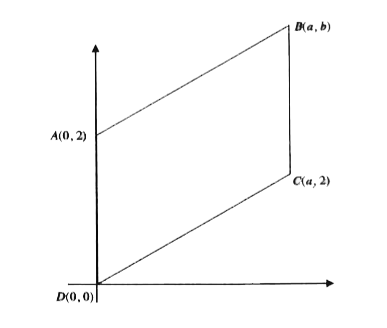ABCD is a parallelogram. If the coordinates of A, B, C are (2,3), (1,4)and (0,−2) respectively, find the coordinates of D.
To find the coordinates of point D in the parallelogram ABCD, we can use the properties of vectors. Here’s a step-by-step solution:
Step 1: Identify the Given Points
We are given the coordinates of points A, B, and C:
- A(2, 3)
- B(1, 4)
- C(0, -2)
Step 2: Assign Coordinates to Point D
Let the coordinates of point D be (x, y).
Step 3: Use the Property of Parallelograms
In a parallelogram, the vector from A to B (AB) is equal to the vector from D to C (DC). This means:
→AB=→DC
Step 4: Calculate the Vector AB
The vector AB can be calculated as:
→AB=B−A=(1,4)−(2,3)=(1−2,4−3)=(−1,1)
Step 5: Calculate the Vector DC
The vector DC can be expressed as:
→DC=C−D=(0,−2)−(x,y)=(0−x,−2−y)=(−x,−2−y)
Step 6: Set the Vectors Equal
Since →AB=→DC, we can set the components equal to each other:
(−1,1)=(−x,−2−y)
Step 7: Solve for x and y
From the equality of the components, we have two equations:
1. −1=−x → x=1
2. 1=−2−y → Rearranging gives y=−2−1=−3
Step 8: Write the Coordinates of D
Thus, the coordinates of point D are:
D(1,−3)
Final Answer
The coordinates of point D are (1, -3).
---
We are given the coordinates of points A, B, and C:
- A(2, 3)
- B(1, 4)
- C(0, -2)
Let the coordinates of point D be (x, y).
In a parallelogram, the vector from A to B (AB) is equal to the vector from D to C (DC). This means:
→AB=→DC
The vector AB can be calculated as:
→AB=B−A=(1,4)−(2,3)=(1−2,4−3)=(−1,1)
The vector DC can be expressed as:
→DC=C−D=(0,−2)−(x,y)=(0−x,−2−y)=(−x,−2−y)
Since →AB=→DC, we can set the components equal to each other:
(−1,1)=(−x,−2−y)
From the equality of the components, we have two equations:
1. −1=−x → x=1
2. 1=−2−y → Rearranging gives y=−2−1=−3
Thus, the coordinates of point D are:
D(1,−3)
The coordinates of point D are (1, -3).
Topper's Solved these Questions
Similar Questions
Knowledge Check
In the rectangular coordinate system shown, ABCD is a parallogram. If the coordinates of the points A,B,C and D are (0,2),(a,b),(a,2) and (0,0), respectively, then b =
 A0B2C3D4
A0B2C3D4
Suppose ABCD is a quadrilateral such that the coordinates of A, B and C are (1,3)(−2,6)and(5,−8) respectively. For what choices of coordinates of D will make ABCD a trapezium ?
View SolutionSuppose ABCD is a quadrilateral such that the coordinates of A, B and C are (1,3)(−2,6)and(5,−8) respectively. For what choices of coordinates of D will make ABCD a trapezium ?
View SolutionThe coordinates of the mid points of sides AB, BC and CA of ABC are D(1,2,−3), E(3,0,1)and F(−1,1,−4) respectively. Write the coordinates of its centroid.
View SolutionThe coordinates of the mid points of sides AB, BC and CA of ABC are D(1,2,−3), E(3,0,1)and F(−1,1,−4) respectively. Write the coordinates of its centroid.
View SolutionIf the coordinates of the points A,B,C,Dbe(1,2,3),(4,5,7),(4,−3,6)and(2,9,2) respectively then find the angle between AB and CD.
View SolutionA ,B and C are the points (2,0),(5,0)and(5,3) respectively. Find coordinates of D such that ABCD is a square.
View SolutionThe three vertices of a parallelogram taken in order are (−1,0), (3,1) and (2,2) respectively. Find the coordinates of the fourth vertex.
View Solution
